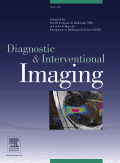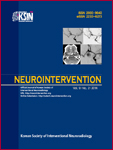
INTERVENTIONAL NEURORADIOLOGY
Scope & Guideline
Pioneering Research in Neuroradiological Interventions
Introduction
Aims and Scopes
- Endovascular Treatment Techniques:
The journal extensively covers endovascular treatment strategies for various neurovascular conditions, including aneurysms, arteriovenous malformations, and acute ischemic strokes. This includes discussions on the efficacy and safety of devices such as flow diverters and stent retrievers. - Innovative Imaging Modalities:
Research on advanced imaging techniques, such as high-resolution MRI, CT angiography, and digital subtraction angiography, is a core focus. These studies are critical for improving diagnostic accuracy and guiding therapeutic decisions in neurointerventional procedures. - Patient Outcome and Safety Assessments:
The journal emphasizes studies that evaluate patient outcomes, safety profiles, and complications associated with neurointerventional procedures. This includes analyses of factors influencing recovery and long-term results following various treatments. - Multidisciplinary Approaches:
Interventional Neuroradiology encourages a multidisciplinary approach to treatment, integrating insights from neurology, surgery, and radiology to enhance patient care and procedural efficacy. - Technological Innovations:
The journal highlights technological advancements in neuroendovascular devices and techniques, including novel catheter designs, embolization agents, and robotic-assisted procedures, which are pivotal in improving procedural outcomes.
Trending and Emerging
- Robotic and AI-Assisted Procedures:
There is a growing interest in the integration of robotic technologies and artificial intelligence in neurointerventional procedures, aimed at enhancing precision and reducing human error during interventions. - Patient-Centric Approaches:
Emerging research focuses on patient-reported outcomes and quality of life following neurointerventional treatments, highlighting the importance of understanding patient perspectives in treatment efficacy. - Advanced Imaging Techniques:
Increased emphasis on the use of advanced imaging modalities, such as 3D rotational angiography and machine learning algorithms for imaging analysis, reflects a trend towards improving diagnostic capabilities and procedural planning. - Safety and Efficacy of New Devices:
There is a notable rise in studies evaluating the safety and efficacy of newly developed devices and techniques for treating complex neurovascular conditions, including flow diverters and novel stent designs. - Real-World Evidence and Registries:
Research utilizing real-world data and multicenter registries is becoming more prevalent, providing insights into the effectiveness and safety of interventions in diverse patient populations.
Declining or Waning
- Traditional Surgical Techniques:
There appears to be a waning focus on comparative studies of traditional open surgical techniques versus endovascular methods, as the latter gain prominence due to their minimally invasive nature and improved patient outcomes. - Basic Research on Thrombosis Mechanisms:
Research papers solely focused on the fundamental biology of thrombosis and hemostasis are less frequently published, as the journal shifts towards clinical applications and procedural advancements. - Case Reports on Rare Conditions:
There is a noticeable decrease in the number of case reports addressing rare neurovascular conditions, likely due to the journal's emphasis on broader clinical studies and meta-analyses that provide more comprehensive data. - General Reviews without Novel Insights:
The journal has moved away from publishing general review articles that do not contribute new insights or advancements, favoring research that presents innovative findings or significant clinical implications.
Similar Journals

Stroke-Vascular and Interventional Neurology
Pioneering the future of stroke and interventional neurology.Stroke-Vascular and Interventional Neurology, published by WILEY, is a leading open-access journal dedicated to advancing the field of neurology with a particular focus on stroke and vascular interventions. Since its inception in 2021 as an open-access journal, it has fostered a collaborative environment for researchers, clinicians, and educators to share innovative findings and clinical practices that address the complexities of cerebrovascular diseases. The journal emphasizes high-quality, peer-reviewed research articles, reviews, and case studies, providing critical insights into cutting-edge therapies and surgical techniques. With an ISSN of 2694-5746, it aims to support the global medical community in improving the diagnosis, treatment, and overall management of stroke patients. Researchers and healthcare professionals benefit from its accessible content, which is vital for fostering comprehensive understanding and evidence-based practices within the realm of interventional neurology.

Japanese Journal of Radiology
Advancing the Frontiers of Medical ImagingThe Japanese Journal of Radiology, published by SPRINGER, serves as a premier platform for disseminating cutting-edge research and clinical advancements in the fields of radiology, nuclear medicine, and imaging. With an ISSN of 1867-1071 and E-ISSN 1867-108X, this journal has established itself as a vital resource for practitioners, researchers, and students alike. Renowned for its high-quality peer-reviewed articles, it currently enjoys a respectable impact factor within the Q2 category of Scopus rankings, placing it in the 69th percentile among 333 journals in its field. The journal has seen consistent convergence of research from 2009 to 2024, further underscoring its commitment to advancing the understanding of radiological practices. Importantly, the journal offers Open Access options to facilitate widespread dissemination of knowledge, ensuring that vital research reaches its audience without barriers. Addressed in Japan, the Japanese Journal of Radiology plays a critical role in enhancing the global discourse on medical imaging, making it an essential resource for anyone engaged in this dynamic field.

Brain Circulation
Fostering Collaboration in Neurovascular ResearchBrain Circulation, published by Wolters Kluwer Medknow Publications, is a premier open-access journal dedicated to advancing knowledge and research in the field of neurovascular health and brain circulation. Since its inception in 2015, this journal has played a pivotal role in disseminating high-quality research articles, reviews, and case studies that explore the intricate relationship between cerebrovascular dynamics and neurological disorders. The journal is committed to fostering a collaborative environment for global researchers, healthcare professionals, and students, aiming to improve outcomes in neuroprotection and treatment strategies. Although it does not currently have an H-index listed, its focus on innovative research ensures its growing significance within the academic community. With a user-friendly open-access model, Brain Circulation invites contributions that enhance understanding and reshape practices in neurovascular care, making it an essential resource for those dedicated to unraveling the complexities of brain health.

Techniques in Vascular and Interventional Radiology
Leading the Charge in Vascular and Interventional Research.Techniques in Vascular and Interventional Radiology, published by Elsevier, is a distinguished journal dedicated to the rapidly evolving field of vascular and interventional radiology. With an ISSN of 1089-2516 and an E-ISSN of 1557-9808, this journal serves as a critical platform for disseminating innovative research and practical advancements in the diagnosis and management of vascular diseases. Operating from the United States, it has established a significant presence in the academic community, evidenced by its 2023 Scopus rankings placing it in the Q3 quartile for both Cardiology and Cardiovascular Medicine and Radiology, Nuclear Medicine and Imaging. The journal aims to publish high-quality articles that encompass both clinical applications and novel technologies, making it an essential resource for researchers, clinicians, and students alike. With its commitment to fostering knowledge and collaboration in this vital area of medicine, Techniques in Vascular and Interventional Radiology plays a key role in advancing patient care and clinical practice.

Clinical Neuroradiology
Innovative Insights for Clinical Excellence.Clinical Neuroradiology, published by SPRINGER HEIDELBERG, is a leading journal in the fields of neurology and radiology, focusing on the intersection of clinical practice and cutting-edge imaging technologies. With an impressive impact factor and categorized within Q2 in Neurology (clinical) and Q1 in Radiology, Nuclear Medicine and Imaging, this journal is positioned at the forefront of scientific discourse, facilitating high-quality research dissemination from its origins in 2000 through to 2024. Situated in Germany, Clinical Neuroradiology provides a platform for researchers, professionals, and students to explore the latest advancements and insights in neuroimaging, ensuring that its readership remains at the vanguard of clinical practice. While it does not offer open access, the journal remains committed to fostering a vibrant academic community dedicated to enhancing patient care through innovative neuroradiological techniques and findings.

JOURNAL OF VASCULAR AND INTERVENTIONAL RADIOLOGY
Advancing the Frontiers of Vascular InnovationJOURNAL OF VASCULAR AND INTERVENTIONAL RADIOLOGY, published by Elsevier Science Inc, is a leading interdisciplinary journal dedicated to the advancement of vascular and interventional radiology research and practice. With an ISSN of 1051-0443 and an E-ISSN of 1535-7732, this esteemed journal serves as a vital platform for disseminating high-quality research from 1990 to present, showcasing significant contributions in the fields of cardiology, cardiovascular medicine, and radiology. The journal holds a commendable position within its categories, being ranked in the Q2 quartile for 2023 in cardiology and cardiovascular medicine as well as radiology, nuclear medicine, and imaging, indicating its relevance and impact within these domains. A notable aspect of this journal is its commitment to enlightening the medical community with cutting-edge findings and innovative techniques in interventional radiology, which are crucial for improving patient outcomes. Despite not being an open-access journal, it remains widely accessible through institutional subscriptions, ensuring that researchers, healthcare professionals, and students can engage with and contribute to its rich repository of knowledge.

Iranian Journal of Radiology
Commitment to Excellence in Diagnostic Imaging ResearchWelcome to the Iranian Journal of Radiology, a pivotal platform dedicated to advancing the field of radiology, nuclear medicine, and medical imaging. Published by BRIEFLAND, this journal aims to disseminate high-quality original research, reviews, and clinical studies that contribute substantially to the global scientific community. Established in 2008 and spanning until 2024, the journal provides an essential archive of knowledge in a rapidly evolving discipline. Although it currently holds a Q4 quartile ranking in the 2023 Scopus metrics, it serves as an important resource for both emerging and established researchers looking to submit their work. Located in the Netherlands, the journal is committed to open dialogue and collaboration amongst professionals in the field, reflecting its accessibility and relevance to both practitioners and academics. With its continued growth and commitment to quality, the Iranian Journal of Radiology is poised to enhance understanding and innovation in diagnostic imaging.

Diagnostic and Interventional Imaging
Empowering Healthcare through Advanced Imaging KnowledgeDiagnostic and Interventional Imaging, published by Elsevier Masson, stands as a prominent journal in the fields of Radiology, Nuclear Medicine, and Imaging. With a significant impact factor and a reputation for high-quality research, this journal is dedicated to advancing the understanding and application of diagnostic and interventional imaging techniques. It has achieved an impressive Q1 ranking across multiple categories including Medicine (miscellaneous) and Radiological and Ultrasound Technology, demonstrating its esteemed position within the academic community. The journal features cutting-edge studies and reviews, reflecting the latest innovations and practices from 2012 to 2024. Researchers, healthcare professionals, and students alike can look forward to accessing valuable insights that drive forward the discipline and improve patient outcomes, as evidenced by its robust Scopus rankings placing it among the top journals in its domain.

Neurointervention
Transforming Knowledge into Clinical ExcellenceNeurointervention, published by the Korean Society of Interventional Neuroradiology (KSIN), is a distinguished Open Access journal that has been a pivotal resource in the fields of neurology and radiology since its inception in 2011. With an ISSN of 2093-9043 and E-ISSN 2233-6273, this journal serves as a vital platform for disseminating innovative research, clinical practices, and advancements in interventional neuroradiology. Situated in South Korea, Neurointervention enjoys a respectable standing in scholarly circles, currently categorized as Q3 in both Neurology (clinical) and Radiology, Nuclear Medicine and Imaging for 2023. It features rigorous peer-reviewed articles, aimed at fostering knowledge exchange and improving patient outcomes in these dynamic fields. As it converges research endeavors from 2019 to 2024, the journal is essential for researchers, clinicians, and students aspiring to stay at the forefront of neurointerventional techniques and methodologies.

European Stroke Journal
Transforming knowledge into stroke prevention strategies.The European Stroke Journal, published by SAGE Publications Ltd, is a pivotal resource in the domains of Cardiology and Neurology, reflecting its commitment to advancing knowledge and research in these critical areas of medicine. Since its inception in 2016, this journal has rapidly gained recognition, achieving a prestigious Q1 ranking in both Cardiology and Neurology (clinical) as of 2023, placing it among the top quartile publications in these fields. With a prominent position, ranked 65th and 72nd respectively in Scopus for Cardiology and Neurology, the journal caters to a diverse audience of researchers, clinicians, and students dedicated to improving stroke treatment and prevention strategies. Although it operates under a traditional access model, its impactful publications are essential for anyone involved in stroke research, ensuring they remain at the forefront of scientific developments and clinical practices.